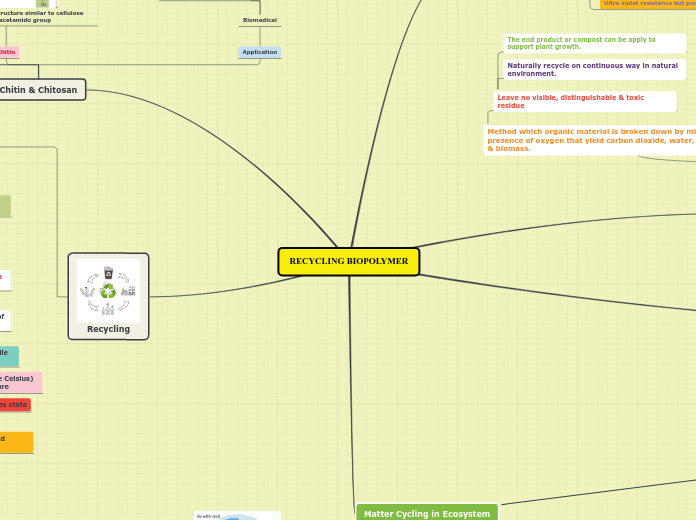av Azrulnizzan Shah Bin Zulkifli för 5 årar sedan
363
RECYCLING BIOPOLYMER

av Azrulnizzan Shah Bin Zulkifli för 5 årar sedan
363

Mer av detta
Reprocessing
Agglomeration - crumbs or agglomerates state
Extrusion- produce pellets from recycled material
Washing & Drying
Wash by cold & hot water ( 60 degree Celsius) and dried until less than 0.1% moisture
Shredding
Reduce size of scrap by shredder into smaller pile of plastic flakes.
Sorting
Plastics waste are separated from impurities and different type of plastic grade
Techniques
Eddy current separator - use of electric current to separate non-ferrous material
Induction Sorting- inductive sensor detect types of metal & separated by fast air blast
Tissue Engineering
prepared in porous form permitting cell growth into tissue
wound dressing for wound skin
Interaction with biotic component- predation, competition, symbiosis,parasitm
Plants, animals, bacteria/fungi
Producer, consumer & decomposer
water, air, temperature, soil, light level, precipitation, salinity
Nitrogen enter the soil and ocean by lightning & nitrogen fixing bacteria
bacteria turn nitrogen gas from the atmosphere into ammonia.
In nitrification, a host of soil bacteria participate in turning ammonia into nitrate – the form of nitrogen that can be used by plants and animals
In nitrogen assimilation, plants finally consume the nitrates made by soil bacteria and use them to make nucleotides, amino acids, and other vital chemicals for life.
In the final step of the nitrogen cycle, anaerobic bacteria can turn nitrates back into nitrogen gas. This process, like the process of turning nitrogen gas into ammonia, must happen in the absence of oxygen
ammonification is performed by soil bacteria which decompose dead plants and animals &the decomposers break down amino acids and nucleic acids into nitrates and ammonia and back into the soil. The ammonia taken up by plants and nitrifying bacteria.
Carbon enters the atmosphere as carbon dioxide from respiration (breathing) and combustion (burning).
Carbon dioxide is absorbed by producers (life forms that make their own food (plants) to make carbohydrates in photosynthesis . These producers then put off oxygen
Animals feed on the plants & most of the carbon these animals consume exhaled as carbon dioxide through the process of respiration. The animals and plants then eventually die.
The dead organisms (dead animals and plants) are eaten by decomposers in the ground. The carbon that was in their bodies is then returned to the atmosphere as carbon dioxide
Evaporation- sun heat the water, turning it into water vapor which rises into the air.
Transpiration-water vapor release into the air from people, animal & plant when warmed by sun
Condensation- cooled water vapor in air form tiny water droplets in sky
Precipitation- when water droplets fall from sky as rain, snow.
Percolation-water seeps deeper into tiny spaces in the soil and rock.
low leachate & methane gas production
Enriches soil by production of beneficial bacteria & fungi to create a rich nutrient material in plantation
Naturally recycle on continuous way in natural environment.
The end product or compost can be apply to support plant growth.